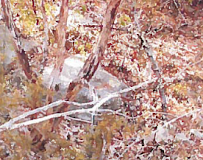Lakeline Sink is a sinkhole located in Cedar Park, Texas. Only so biology and history is known about this sinkhole. This news article will explain the history and biology behind Lakeline Sink.

Lakeline Sink is a sinkhole located north of Lakeline Mall in Cedar Park, Texas. The perimeter of this sinkhole 1 foot wide and 3 feet in depth. This sinkhole does not connect to any caves or aquifers that are in the area. The depth of this sinkhole extends downwards 3 feet before dead-ending. 


Accessibility to Lakeline Sink is difficult because this sinkhole is surrounded by a metal fence and is accessible only through one gate. There are no other shortcuts to access this sinkhole. However the sinkhole itself is not gated and is still accessible. Exploring or visiting this sinkhole during the wintertime is best because there will be a lack of tall grass and insects in the way. Be careful of the cedar trees and oak trees in the area.
Throughout much of the 20th century, Lakeline Sink was once located on a 46.7-acre tract at 2801 S. Lakeline Blvd., immediately north of Lakeline Mall prior to 1985. The entire tract was covered by trees, shrubbery, and caves. Very little development surrounded the area if anything. Lakeline Sink was a small sinkhole located in a grassy covered area hidden entirely by cedar trees at that time. (Ref: www.austintexas.gov/edims/document.cfm?id=166006)


Lakeline Sink was discovered by Bill Russell of Texas Speleological Survey on his way back from exploring Garden-of-Sinks Cave in 1984. He had not been able to find this small sinkhole and Lakeline Cave before. He had wanted to see this sinkhole himself for a very long time as spelunking was his desire of course and because he was concerned Lakeline Cave would be an environmental problem since he was an environmental activist. He attempted to explore the area himself but his search for Lakeline Cave turned up empty. Then he realized he was going to need help. So he invited a member from Texas Speleological Survey.
Bill Russell and Erika Heinen of Texas Speleological Survey had later decided to explore the property in hopes of discovering Lakeline Cave. They had not been able to find this small cave reported on the property, but wanted to visit the cave to see if it would be or would have been an environmental problem. When first located, the entrance to Lakeline Sink was a trash and barbed-wire filled sink. The sink was cleared after a rock was removed by Bill Russell and Erika Heinen. However this was easy digging for them as not much needed to be dug. (Ref: https://digital.lib.usf.edu/content/SF/S0/05/47/93/00001/K26-04344-KIP-00011524.pdf)
Simon Properties bought 200 acres of land northwest of Austin in 1985 for construction of the proposed Lakeline Mall. Construction was supposed to start in 1986, however a rare insect species called Texella reyesi was discovered to be living on the property. USFWS stepped in and issued an injunction against Simon Properties and Simon Lakeline Mall Partnership to prevent them from continuing development until all the permits could be filled out. The developers were told Texella reyesi and Texella reddelli are a federally-listed species. So work had to cease.
City workers stepped in and cleared some of the land to locate the sinkhole in 1987. In order for city workers to find this sinkhole, they needed help from Texas Speleological Survey. So Bill Russell agreed to place flagging tape on trees near the sinkhole and caves so it would be easy to find and for city workers to access.
Lakeline Sink had been treated twice in 1990 and 1991, but not since a study was done in 1991. This cave was left in a small preserve called Lakeline Cave Preserve during that same year after the City of Cedar Park called for the creation of a 2.3-acre “research preserve” around Lakeline Sink called Lakeline Cave Preserve also known as Lakeline Cave Research Preserve, Lakeline Research Preserve, and Lakeline HCP. (Ref: http://www.austintexas.gov/edims/document.cfm?id=166006)
The Lakeline Research Preserve treated the Lakeline Sink sinkhole from 1991 to 1995. Lakeline Research Preserve was turned over to Cedar Park in 1995. Research of Lakeline Sink ceased in 1995 when Lakeline Sink was turned over to Cedar Park as Lakeline Cave was privately owned for research and environmental purposes. Lakeline Sink was owned by the City of Cedar Park prior to 2000. In 2000, the City of Cedar Park transferred ownership of Lakeline Sink to the City of Austin. Today the City of Austin owns Lakeline Sink.
The address and location for Lakeline Sink is 2801 South Lakeline Boulevard, Cedar Park, Texas, US 78613. However Lakeline Sink is actually located alongside Pecan Park Boulevard.


No comments:
Post a Comment